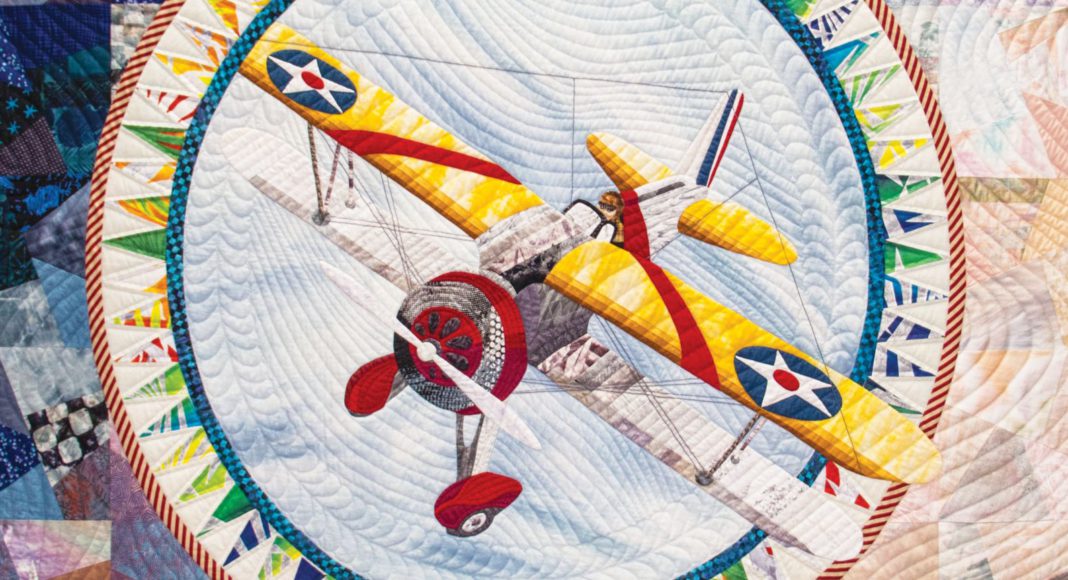Quilts evoke warmth and comfort, but they can also turn function into art. Like many art forms, quilts can even be political. The San Jose Museum of Quilts & Textiles’s latest exhibit, “Jonathan Shannon: Creativity, Collecting, Controversy,” is a retrospective on the artist, who had a relatively short career as a quilter, but made a big impact.
“He set out to be the very best in that field that he could be,” says museum curator Nancy Bavor. “He set his goals very high. He set a standard for himself. And he worked very, very hard. That’s what this exhibition is and his lifelong works reflect that.”
Shannon was born in Arizona in 1938 and graduated from UCLA. He worked in textiles, fashion and interior design, designing for Lucille Ball, Ann-Margret and Zsa Zsa Gabor. He ran a clothing store in LA in the 1960s and 70s. When he retired at age 50, Shannon took up quilting after finding an antique bed quilt in the Sonoma house he shared with his partner, Jeffrey Ross.
“He thought, ‘I know how to sew. How hard could making a quilt be?’” says Bavor. “So he took a few classes, and because he was trained as an artist, he really developed early on his own style and perfected his technique.”
Most of the display’s 20 pieces were donated by Ross and taken from the museum’s permanent collection, are hand pieced, hand appliqued and machine pieced, and use Japanese, Central and South American fabrics, among others. While quilts might be considered old-fashioned chic to some, Shannon’s style is both traditional and abstract, and his imagery runs the gamut from sunflowers to fish to Japanese samurai.
“Air Show” (1992), with its 1930s biplanes, made Shannon the first man to win Best of Show at the American Quilter’s Society show and contest in Paducah, K.Y. “Canciones de Mi Padre” (1989), named after Linda Ronstadt’s legendary 1987 Spanish-language album, features fans, flying darts and hearts shaped in a spiral pattern. “Totem: The Fear of Black and White” (1990), on the other hand, is inspired by African masks, hand painted and embellished with buttons, tubes and stuffed balls hanging off the bottom.
It was “Amigos Muertos” (1994), however, that garnered Shannon notoriety. The quilt, which took a year to complete, depicts two skeletons—one holding a guitar and wearing a red, AIDS ribbon—dancing above a grapevine and surrounded by a border of papel picado. It’s an homage to Day of the Dead that also pays tribute to friends and artists who’ve died of AIDS and cancer. But it was rejected that year by the American Quilter’s Society show, whose officials claimed that viewers would be upset by the content. Shannon felt he was censored for his subject matter. (Both “Air Show” and “Amigos Muertos” are among the 100 included in Mary Leman Austin’s 1999 book, The Twentieth Century’s Best American Quilts.)
“Is it because it’s skeletons?,” asks Bavor. “Is it because it’s about AIDS? Is it because it was made by a gay man? Who knows, but they felt that their viewers would not want to see that image.”
Similar in theme, his “Shadows Gay Men’s Chorus” (1995) is based off of a 1985 San Francisco Chronicle photo of the Gay Men’s Chorus, which shows only seven surviving original members, out of 125, from the choir since its founding in 1978. It’s a stark reminder of AIDS’s devastating effect on the LGBTQ community at its height in the 1980s.
Shannon, who died in 2017, quilted for only a decade, and doesn’t have an official website or social media presence, so Bavor hopes the exhibit will not only bring attention to his work, but the importance of protecting artistic expression.
“People need to know what a significant contribution he made to the quiltmaking world and the excellent things he did,” she says. “It’s something that started the discussion in the quiltmaking world, which tends to be very traditional and conservative, that censorship is never OK.”
Jonathan Shannon: Creativity, Collecting, Controversy
San Jose Museum of Quilts & Textiles
520 S. First Street, San Jose
408.971.0323
Thru April 7
Fri–Sun, 11am–5pm, $10



